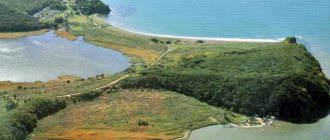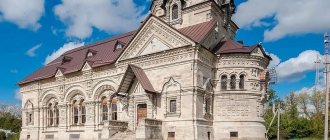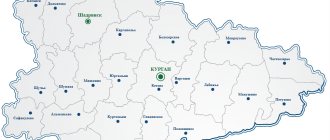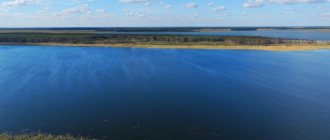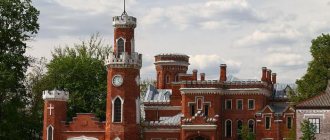One of the richest and second largest region in terms of area is the Krasnoyarsk Territory, located in Central and Northern Siberia. It is the largest among other regional administrative units. Yandex maps of the Krasnoyarsk Territory allow you to get to know in more detail the infrastructure of the region, its cities, rivers and other objects.
Scientists date the appearance of the first people on the lands of the region to the Paleolithic period. The first states were formed here several centuries BC. The Krasnoyarsk region is rich in forests, wild animals live here, and over time, scientists discovered mineral deposits of gold and platinum. Maps of the Krasnoyarsk Territory with diagrams will help you examine the entire territory of the region and get an idea of its borders, regions, and settlements. The online service allows you to zoom in to study a particular object in detail, move around the territory, and find interesting places and attractions.
The borders of the region are very vast. Use interactive satellite maps of the Krasnoyarsk Territory, and you will see that its borders are adjacent to several subjects at once:
- Tuva;
- Yakutia;
- Kemerovo region;
- Yamalo-Nenets Autonomous Okrug;
- Irkutsk region;
- Khanty-Mansi Autonomous Okrug.
The northern borders are washed by the waters of the Arctic Ocean. Most of the region belongs to the Arctic. A detailed map of the Krasnoyarsk Territory shows that the entire territory of the region is divided into 2 unequal halves by the Yenisei River. Also, using the online service, you can consider other hydrographic objects, for example, the largest lake Taimyr. By zooming in on the map, you can also find other significant lakes:
- Pyasino;
- Bolshoe Khantaiskoe;
- Lama;
- Chum salmon.
The most lakes, as the map with the regions of the Krasnoyarsk Territory shows, are located in the center and south of the region. There are also reservoirs with medicinal waters in the region.
Geographical position
Krasnoyarsk Territory is a subject of the Russian Federation, located in the Siberian Federal District, the administrative center is Krasnoyarsk.
It borders with the Republic of Yakutia (Sakha) and the Irkutsk region in the east, with the Republics of Tyva and Khakassia in the south, with the Kemerovo and Tomsk regions, Khanty-Mansiysk and Yamalo-Nenets autonomous okrugs in the west.
It is the second largest subject of the Russian Federation by area after the Republic of Yakutia (Sakha). It occupies an area of 2,366,797 sq. km, which is 13.86% of the territory of Russia.
Krasnoyarsk region from ancient centuries to the 17th century.
The first people settled here about 200 thousand years ago. Over the centuries, several great human migrations have swept through the area. The north of the region was populated from the end of the 1st millennium BC. e. The territory of the region was settled along the Yenisei valley from south to north. The first inhabitants were representatives of the Mongoloid race, which is confirmed by the study of the remains of a Mongoloid skull found at the paleontological site of Afontova Gora (territory of the city of Krasnoyarsk). Before the arrival of the Russians, a few Turkic, Samoyed, Tungus and Yenisei tribes lived here - the ancestors of modern peoples (Dolgans, Nenets, Evenks) - who had a unique ancient culture and a special way of life. Many tribes, tribal unions, primitive states appeared and disappeared on this land.
The new history of the Yenisei country begins with its entry into the Russian state.
The first detachments of fishermen and service people began to penetrate here since the end of the 16th century. For the first time, Russian troops under the command of Fyodor Dyakov reached the banks of the Yenisei in 1598. But the Russians did not stay here for long. Only with the foundation of the Mangazeya fort on the Taz River was a solid base created for the establishment of Russian influence in the Yenisei land.
In 1607, the first permanent Russian settlement in the region was founded - Turukhanskoye winter quarters (later the city of Turukhansk). The Russians penetrated into Eastern Siberia along the Ket River, the right tributary of the Ob. In 1619, a detachment of servicemen marched along this road under the leadership of the son of the boyar Albychev and the streltsy centurion Cherkas Rukin, who founded the city of Yeniseisk.
The Russian conquest went from north to south. In the first half of the seventeenth century, wooden fortress-forts of Krasnoyarsk (1628), Achinsk (1641), Kansk (1636) appeared in the Yenisei basin.
The first Russian inhabitants of the region were service Cossacks. The indigenous population did not particularly object to the Russian presence. The exception was the Yenisei Kirghiz, stubborn battles with whom continued until the beginning of the 18th century, when united detachments of the cities of Krasnoyarsk, Yeniseisk, Tomsk and Kuznetsk completely defeated the warlike steppe inhabitants in several battles. In 1623, the huge Yenisei district was formed, which included not only the lands around the great river, but also the entire Angara region. Yeniseisk became its center. In 1629, the entire Yenisei region became part of the Tomsk region. Over the course of a century and a half, the administrative-territorial division changed repeatedly.
Administrative-territorial division of the Krasnoyarsk Territory in the 17th – early 20th centuries.
Russian development of Central Siberia began in the mid-late 16th century. and went mainly from northwest to southeast. At the first stage, Russian explorers, fishermen and servicemen, having quickly mastered the Yenisei Arctic and the taiga zones of the lower and part of the middle Yenisei, reached the border of the forest-steppe, which was controlled by the Yenisei Kyrgyz. At this time, the Yenisei (1619), Krasnoyarsk (1628), Kansk (1636-37) and Achinsk (1641) forts were founded, which in our time have become the largest populated areas in the country. In the second half of the 17th century. – first quarter of the 18th century. The Russians reached the northern Sayan region, founding in 1675. Guardhouse, in 1707 - Abakansky and in 1718. - Sayan prison. Since the 18th century The rapid settlement of Russians in the south of the Yenisei region began, where by the end of the century most of the population of the entire Central Siberia ended up. With the final construction of the world's largest land road - the Moscow-Siberian Highway, Yeniseisk began to lose its significance as the gateway to Eastern Siberia and its largest commodity distribution and trading center. Gold mining boom of the 30s-50s. XIX century only temporarily revived the economic life of the northern part of Central Siberia. The leading role passed to the tract and southern regions of the region, especially with the holding in the late 90s. XIX century Trans-Siberian Railway. The stages and features of the settlement and economic development of Central Siberia were to a certain extent reflected in its administrative-territorial division. The first counties were geographically extended from the northwest to the southeast, and their centers were shifted to the west in relation to their main territory. With the further disaggregation of the districts, territories outside their boundaries turned out to be economically and transport weakly connected with the river system of the Yenisei and Chulym river basins. In the 17th century the territory of the region was divided into Mangazeya or Turukhansky district (established in 1601); Yenisei (1619) and Krasnoyarsk (1630-1631) districts. Until February 19, 1637 all districts of Siberia were governed by the order of the Kazan court, and then by the Siberian order separated from it. Mangazeya and Yenisei districts were part of the Tobolsk category (a larger territorial unit that preceded the province), and then in 1629. all the Yenisei districts were transferred to the new Tomsk category. In 1639-40. The Lensko-Ilimsk region was separated from the Yenisei district. In 1677 Yeniseisk became a discharge city. The Yenisei district included: Yenisei, Mangazei and Nerchinsk districts. Since 1681 Krasnoyarsk district was included in it, since it is “a long distance from Tomsk, and closer to Yenisei” fort. Since 1682 Irkutsk and Albazin districts were included in the Yenisei category. In the 18th century according to the first regional reform of Peter I, all of Siberia became part of the Tobolsk province of the Siberian province with the center in Tobolsk (12/18/1708). In the Tobolsk province since 1719. two more provinces were allocated, including the Yenisei province with its center in Yeniseisk. All three districts of the region (as tax units, they were called districts at that time) were part of the Yenisei province. Until 1736 it also included Tomsk, Kuznetsk and Narym districts of Western Siberia. In 1782 Krasnoyarsk district entered the newly established Kolyvan region, which from December 27, 1783. was elevated to the rank of a province (government) with its center in the city of Berdsk, renamed Kolyvan. Plans to move the center of the Krasnoyarsk district from Krasnoyarsk to the Abakan prison were not realized. From 08/30/1782 The Yenisei and Turukhansk districts became part of the Tomsk region of the Tobolsk governorship. The newly established Achinsky district was also listed there, where 6 old-time settlements of the Krasnoyarsk district, lying between Krasnoyarsk and the Kazachinsky threshold, the southwestern part of the Yenisei district and the northeast of the Tomsk district were transferred. In 1783 the eastern part of the Krasnoyarsk district along the right bank of the Kan went to the newly established Nizhneudinsky district of the Irkutsk locality (Kanskaya and Biryusinskaya settlements). In 1783-87. in counties, courts and volosts began to be disaggregated into uniform small administrative-territorial units - volosts. In 1797 governorates were renamed into provinces, and Kolyvan was abolished altogether. Krasnoyarsk, Yenisei and Turukhansk districts in the old ones before 1782-83. borders (with the exception of the eastern part of the Krasnoyarsk district) entered the Tobolsk province. Achinsk district was liquidated, and the city of Achinsk itself became unemployed. In 1804 The Yenisei districts became part of the newly established Tomsk province with its center in Tomsk. In 1805 in the counties, along with the volosts, larger administrative-territorial units were established - commissariat. 07/22/1822 from the Tomsk province, the Yenisei province of the East Siberian General Government was separated, consisting of 5 districts (former counties): Yenisei (it included the territory of the abolished Turukhansk district under the name of the Turukhansk commissariat, later a separate administration); Krasnoyarsk, Kansk (from parts of Krasnoyarsk, Yenisei districts, Ilanskaya and Biryusinskaya volosts of Nizhneudinsk district of Irkutsk province from the Biryusa river to Kan); Minusinsky (from the southern part of Krasnoyarsk district); Achinsky (from the western part of Krasnoyarsk, south-west of Yenisei and north-east of Tomsk districts). In 1856 The East Siberian Directorate was established. The administrative-territorial division of the Yenisei province remained largely unchanged until October 1917. Only the volost division changed. Since 1898 The districts of the Yenisei province began to be called counties again. Local government of the districts of Central Siberia in the first half of the 18th century. after the provincial reform of Peter I it looked like this. Each county was divided into a number of smaller administrative-territorial units - prizes. They were headed by special clerks from the top of the local treasury. In the Yenisei district in 1735. There were 16 awards: The Upper Villages Award; Ust-Tungussky; Kazachinsky (Cossack Meadow); Underground villages; Kemsky fort; Big Elani; Makovsky prison; Kem villages; Belsky fort; Maloketsky (Maloketskaya village); Dubchesskaya Sloboda; Lower Village; Rybinsk prison; Taseevsky prison; Antsiferovsky and Kezhemsky (in Ilimsky district until 1783). In addition, the yasak population was governed by special “yasak volosts”. In the same 1735 in the Yenisei district there were 13 yasak volosts: Chunskaya, Murskaya, Chadobskaya, Ketskaya, Kovinskaya, Teterinskaya, TASEEVSKAYA, Rybinskaya, Symskaya, Kasogovskaya, Inbatskaya, Natskaya and Pumpokalskaya. In Krasnoyarsk district in 1735. there were 12 courts: Podgorodny, Yasaulovsky, Balchessky, Buzimsky, Nakhvalsky, Pavlovsky, Podemny, Spasskaya Nadporozhnaya Sloboda, Karaulny fortress, Kansky fortress, Abakan fortress and Chastostrovsky. In addition, in the Krasnoyarsk district there were 8 yasak “zemlitsa”. In 1786-1787 in Central Siberia, local grassroots governance was changed. Instead of courts, volosts were established headed by zemstvo huts (since 1789 - volost boards). In Krasnoyarsk district in 1783. there were 11 volosts: Podgorodnaya, Zaledeevskaya, Berezovskaya (initially Yasaulskaya), Rybinsk, Kanskaya, Chastoostrovskaya, Nazarovskaya, Krivosheinskaya, Minusinskaya, Kuraginskaya, Balakhtinskaya. In the Achinsk district, according to his establishment, there were 11 volosts: Podgorodnaya (Achinskaya), Krasnorechenskaya, Bogotolskaya and Kiyskaya (all transferred from the Tomsk district), Novoselovskaya (from the Yenisei district), Ustyugskaya, Atamanovskaya, Sukhobuzimskaya, Nakhvalskaya, Podemskaya and Bolshekemchugskaya (from the Krasnoyarsk district ). In the Yenisei district after 1783. there were 20 volosts: Antsiferovskaya, Elanskaya, Maklakovskaya, Belskaya, Kazachinskaya, TASEEVSKAYA, Boguchanskaya, Kezhemskaya, Chadobskaya, Mikhalevskaya, Petropavlovskaya, Ust-Tungusskaya, Podporozhenskaya, Ust-Kemskaya, Antsiferovskaya, Chalbyshevskaya, Novoselovskaya, Ustyanskaya, Troitskaya, Nazimovskaya. In 1804-1805 The lower administrative-territorial division was complicated by the allocation of commissars in counties (districts), which existed until the establishment of the Yenisei province. In 1807 in the Yenisei district, three commissariat were formed from the former volosts. The Elan commissariat consisted of the Belsk, Maklakovsk, Elan, and Antsiferovsk volosts; Boguchanskoe - from Boguchanskaya and Kezhemskaya volosts; Taseevskoye - from Taseevskaya, Ustyanskaya and Kazachinskaya volosts. In the Krasnoyarsk district in 1807. there were 6 commissaries. In the Kansk Commissariat - Kansk and Rybinsk volosts; Ladeysky - Ladeyskaya, Zaledeevskaya, Podgorodnaya and Chastoostrovskaya volosts; Sukhobuzimsky - Sukhobuzimskaya, Nakhvalskaya and Ustyugskaya volosts; Achinsk - Achinskaya and Novoselovskaya volosts; Bogotolsk - Bogotolskaya, Kiyskaya, Nazarovskaya and Balakhtinskaya volosts; Minusinsk - Minusinsk and Kuraginsk volosts. In 1923, work began on zoning Siberia. It was based on the unification of regions according to economic principles. According to the new administrative division, the volosts were transformed into larger units - districts. In June 1924, by resolution of the All-Russian Central Executive Committee, the Yenisei district was abolished and the Turukhansky district was formed with its center in Turukhansk. The transformation of volosts into districts was the first stage in the history of zoning of Siberia. The next step was the formation of districts, replacing the previous provinces and districts. 05/25/1925 The Siberian Territory was formed with its center in the city of Novonikolaevsk (Novosibirsk) from the provinces of Altai, Yenisei, Irkutsk, Novonikolaevsk, Omsk, Tomsk and Autonomous Oirot region. 02.12.1934 Krasnoyarsk region is formed. * From materials of the Archival Agency of the Krasnoyarsk Territory Administration
Krasnoyarsk region in the XVII-XVIII centuries.
In the 17th century part of the modern territory of the region was included in the Tomsk district, part - in the Krasnoyarsk district. The territory of the latter either increased or decreased. In 1724, the Yenisei province was allocated as part of the Siberian province. In 1782 the province was liquidated; its districts were included in the Tomsk region, and fourteen years later, with the abolition of the Tomsk region, the territory of the region was divided between the Tobolsk and Irkutsk provinces and the Kolyvan region. In 1797, the entire Yenisei basin became part of the Tobolsk province, and in 1804 it was transferred to the Irkutsk province.
The Yenisei lands were little developed economically. They were of interest to the government solely as a source of fur. Agriculture and animal husbandry were of a subsistence nature, crafts were in their infancy. Throughout the 17th century, the main characters in Siberian history were serving Cossacks, merchants, and hunters. Peasant farmers were rarely encountered, since farming among non-peaceful tribes was not only difficult, but also deadly. With the defeat of the warlike Yenisei Kyrgyz, the agricultural development of the region accelerated significantly, but still only small territories of the central and southern parts of the Yenisei region were subject to development.
Krasnoyarsk region in the 19th century.
The next stage in the history of the Yenisei region is associated with the reforms of Mikhail Speransky. In 1819, this famous Russian politician was sent with the broadest powers to conduct an audit of Siberia. The reason for the audit turned out to be a completely unsatisfactory state of affairs in the management and economic development of the region. The imperial office was inundated with piles of complaints about the excesses of local administrators. The economic return from the Trans-Ural region was falling, Siberia was turning into a burden for the state. At court and in the periodical press, voices were even heard about the uselessness of Siberian possessions for the country.
As a result of Speransky's reforms, all of Siberia was divided into two governor-generates - Irkutsk and Tomsk. Each of them included several provinces. In 1822, the Yenisei Governorate was formed as part of the Irkutsk General Government. Its center was determined to be the city of Krasnoyarsk. The Moscow Highway passed through it, connecting the city with the center of the country; Yeniseisk, which found itself to the side of the highway, lost its former significance.
The administration of the province was determined by the laws of the Russian Empire. It was headed by a civilian governor, who concentrated administrative, military, and judicial power in his hands. Under the governor there was a council that was supposed to limit his power, but in reality the role of this council was small, since it included officials personally dependent on the governor.
The territory of the province basically coincided with the modern Krasnoyarsk Territory (with the exception of Khakassia). It was divided into five districts - Yenisei, Krasnoyarsk, Kansky, Minusinsk and Achinsky. The Turukhansk Territory was part of the Yenisei Okrug.
In the second half of the 19th century. The Usinsk border district became part of the province. The territory of the Yenisei province exceeded any of the European states, but the population density was one of the lowest not only in Russia, but also in Siberia.
The influx of population was mainly due to immigrants from European Russia, as well as exiles and convicts. Only state peasants could move to Siberia at their own request; serfs came only as exiles. In the Yenisei province, as well as in Siberia as a whole, there was no serfdom. A sharp increase in the number of immigrants occurred in the 30-40s of the 19th century. About 30 thousand peasants from the Vologda, Vyatka, Perm, Yaroslavl, Oryol, and Penza provinces settled in the Yenisei lands. Most of the settlers settled in the southern regions of the Yenisei province, where there were better conditions for farming. In both the 18th and 19th centuries, the main method of allocating land to peasants was the right of seizure. The peasant took as much free land as he could cultivate; then the chosen plots were legally assigned to him in the form of plots. State taxes were also collected from these plots. This method was possible due to the low population density and the large amount of free fertile land. In the early years, virgin lands produced very decent yields. Despite the harsh climatic conditions, the standard of living of Siberian peasants was generally higher than that of European ones.
In the second third of the 19th century. The number of political exiles increased sharply. After the suppression of the Decembrist movement, there were participants in the uprising in the province - only 31 people.
In the 30s of the XIX century. Significant changes have occurred in the province's economy. Gold mining began, which flourished in the 40s and 50s. By 1847, there were 119 mines in the Yenisei region, mainly nesting in the basins of the Kazyr, Kizir, Amyl, Sisim, Biryusa, Uderei, Pit, and Podkamennaya Tunguska rivers. The province was gripped by a gold rush. People of various classes and ranks rushed to mine gold. In terms of the value of products produced, the gold industry has left behind all other industries combined. Over the years, 20-30 thousand workers were employed at the gold mines. The cities of Yeniseisk and Krasnoyarsk experienced a period of rapid growth. Money flowed like a river. The profit of gold miners was sometimes 800-850%. However, gold did not at all contribute to a radical restructuring of the province's economy. It rather played the role of an economic drug. Large miners invested money not in the development of industry, but in luxury goods, and led a cheerful and riotous life. Only a few managed to preserve and increase their capital, but they also invested their funds mostly in trade.
By the middle of the 19th century. The largest capital was transferred by gold miners Vostrotin, Kuznetsov, Danilov, Cheremnykh, Kytmanov, Astashev, Khilkov and others. Small-scale miners usually drank up all their production in the shortest possible time. Since the beginning of the 60s, the volume of gold mining began to fall steadily.
The level of other industries in the province was completely insignificant. Products were produced almost entirely for the domestic market. The province was dominated by small craft enterprises with 5-7 workers. By the end of the 19th century. in the province there was only one large enterprise - the Abakan ironworks, which employed 800 people. In 1833, the Znamensky glass factory was founded near Krasnoyarsk (now the village of Memory of 13 Bortsov).
At the end of the 19th century. The Trans-Siberian Railway passed through the territory of the Yenisei province. The first test train arrived in Krasnoyarsk on December 6, 1895. This event led to significant changes in both the economic and social life of the region.
Economy and industry of the Krasnoyarsk Territory
There are about 17 thousand enterprises operating in the region. The main industrial sectors of the Krasnoyarsk Territory:
- metallurgy;
- mechanical engineering;
- space;
- mining;
- food
The region occupies a leading position in the mining of metal ores, gold and platinum. The region's factories also produce:
- furniture;
- wood;
- paper;
- electrical equipment;
- refrigerators;
- agricultural machinery.
There are ship repair plants at one of the largest shipyards in the country - Krasnoyarsk. Food and processing industry enterprises are also of great importance for the region’s economy.
Krasnoyarsk region in the first half of the 20th century.
Already at the beginning of the twentieth century, the calm and serene life for local authorities ended. Workers' strikes follow one after another. The railway workers are at the forefront of the strike movement. Committees of revolutionary parties appear in cities.
The Yenisei province took an active part in the First Russian Revolution. The most active revolutionary protests took place in Krasnoyarsk, Ilanskaya, and Bogotol. Throughout 1905, strikes at enterprises in Krasnoyarsk hardly subsided, and in December an armed uprising took place in the provincial center, during which power in the city was briefly seized by the United Council from soldiers and workers.
In 1906 - 1907 the strike movement is on the decline, the strikes are of an economic nature. But the peasant movement broke all records. It was especially powerful in the southern regions of the province. According to the Minusinsk police officer, 1906 was a year of “complete anarchy” in the Minusinsk district.
By the end of the first decade of the twentieth century. Local industry has revived somewhat. Technical re-equipment of gold mining enterprises is underway. Foreign capital and large Russian banks are beginning to actively penetrate into the economy of the province. However, there were very few large industrial enterprises in the province - these were the Krasnoyarsk railway workshops (2000 workers), the Znamensky glass factory (900 workers), the Ilan railway depot (700 workers), the Abakan ironworks (500 workers), and the Yulia copper mine (650 workers). ). The remaining enterprises were very small both in terms of the number of employees and the volume of products produced.
The victory of the October Revolution in Krasnoyarsk became known on October 27. And on the night of October 29, a detachment of revolutionary soldiers under the command of Sergei Lazo captured the key points of the city - the bank, treasury, telegraph, and provincial printing house. The Krasnoyarsk Provincial Council of Workers' and Soldiers' Deputies announced the transfer of full power to it and the removal of the provincial commissar Krutovsky from office. Not everyone liked the action of the Bolsheviks - the Krasnoyarsk Socialist Revolutionaries, Mensheviks and Cadets opposed the arbitrariness of the Soviet and condemned the coup in Petrograd. The Achinsk City Duma announced the severance of all relations with the Bolshevik Soviet. The Yenisei Cossacks also refused to recognize Soviet power.
However, the Bolsheviks did not pay much attention to the protests. They formed the Yenisei Provincial People's Commissariat to govern the province, nationalized banks, introduced workers' management at private enterprises, and disbanded all previous governing bodies. In all cities of the province, power also passed into the hands of the Soviets. Revolutionary committees were created in Kansk and Minusinsk to fight the counter-revolution. The Bolsheviks tried to improve the economy of the region. For this purpose, on January 10, 1918, they formed the provincial economic department, later renamed the Council of the National Economy. However, the new government did not achieve much success in restoring and developing the national economy.
The Kolchak authorities returned to the previous order and tried to restore order in the province. However, they were not very successful in creation. Forced conscription into the army, food requisitions, and brutal terror caused discontent among the population. The Czech “allies” of Kolchak’s followers behaved disgustingly, actively engaging in mass robberies, violence, and murders of innocent people. For many years, Siberians recalled with shudder the “exploits” of Czech marauders, and a song with the words “we were attacked by evil Czechs” became popular. As a result, resistance to the Kolchak regime is constantly growing. In Kansk, Ilansk, Krasnoyarsk, Yeniseisk, Minusinsk, uprisings broke out against the whites.
In the 20s, the USSR government was actively involved in reorganizing the administrative-territorial division of the country. In 1925, the Yenisei province was liquidated. Its territory was divided into five districts - Achinsky, Kansky, Krasnoyarsk, Minusinsk, Khakass. They became part of the Siberian Territory with the administrative center in Novosibirsk.
By decree of the Presidium of the All-Russian Central Executive Committee of December 7, 1934, as a result of the disaggregation of the West Siberian and East Siberian territories, the Krasnoyarsk Territory was formed.
The Achinsky, Birilyussky, Bogotolsky, Karatuzsky, Kuraginsky, Minusinsky, Ermakovsky, Nazarovsky, Usinsky and Uzhursky districts, as well as the Khakass Autonomous Region consisting of six districts, moved away from the West Siberian region to the new region. From the East Siberian - the entire Yenisei and Kansky districts, consisting of 21 districts, as well as the Evenki and Taimyr national districts. In total, the region included 52 districts.
The Krasnoyarsk Territory was formed almost within the former borders of the former Yenisei province. The administrative-territorial division in 1935-1936 underwent significant changes. New districts were formed: Berezovsky, Daursky, Idrinsky, Ilansky, Igarsky, Kozulsky, Krasnoturansky and Tyukhtetsky, and in 1936 - the Emelyanovsky district.
Map of the Krasnoyarsk Territory with cities, regions and villages
| 1. Krasnoyarsk | 19. Tyukhtet village. (Tyukhtetsky district) | 37. Zaozerny city | 55. Podtesovo rp (Yenisei district) |
| 2. Nizhniy Ingash rp (Nizhneingashsky district) | 20. Svetlogorsk rp (Turukhansky district) | 38. Nazarovo city | 56. In memory of 13 Fighters rp (Emelyanovsky district) |
| 3. Razdolinsk r.p. (Motyginsky district) | 21. Turukhansk village (Turukhansky district) | 39. Minusinsk | 57. Idrinskoye village (Idrinsky district) |
| 4. Motygino district (Motyginsky district) | 22. Uzhur city (Uzhur district) | 40. Sharypovo city | 58. Ilansky city (Ilansky district) |
| 5. Nizhnyaya Poima rp (Nizhneingashsky district) | 23. Uyar city (Uyarsky district) | 41. Kedrovy village | 59. Kazachinskoye village (Kazachinsky district) |
| 6. Pokanaevka district (Nizhneingashsky district) | 24. Shushenskoye district (Shushenskoye district) | 42. Aban pst (Abansky district) | 60. Irbeyskoye village (Irbeysky district) |
| 7. Novoselovo village (Novoselovsky district) | 25. Uyar city (Uyarsky district) | 43. Sunny village | 61. Emelyanovo rp (Emelyanovsky district) |
| 8. Tinsky rp (Nizhneingashsky district) | 26. Igarka city (Turukhansky district) | 44. Kansk | 62. Dzerzhinskoye village (Dzerzhinsky district) |
| 9. Shalinskoye village (Mansky district) | 27. Taseevo village (Taseevsky district) | 45. Yeniseisk | 63. Rassvet rp (Birilyussky district) |
| 10. Chibizhek rp (Kuraginsky district) | 28. Ural rp (Rybinsk district) | 46. Divnogorsk | 64. Novobirilyussy village. (Birilyussky district) |
| 11. Artemovsk (Kuraginsky district) | 29. Irsha rp (Rybinsk district) | 47. Borodino city | 65. Boguchany village (Boguchansky district) |
| 12. Algashtyk village (Krasnoturansky district) | 30. Sayansky district (Rybinsk district) | 48. Lesosibirsk | 66. Bolshaya Murta rp (Bolshemurtinsky district) |
| 13. Kuragino rp (Kuraginsky district) | 31. Aginskoye village (Sayansky district) | 49. Sosnovoborsk | 67. Bolshoy Uluy village. (Bolsheuluisky district) |
| 14. Bolshaya Irba rp (Kuraginsky district) | 32. North Yenisei rp (North Yenisei district) | 50. Bogotol | 68. Predivinsk rp (Bolshemurtinsky district) |
| 15. Krasnokamensk r. (Kuraginsky district) | 33. Sukhobuzimskoe village. (Sukhobuzimsky district) | 51. Achinsk | 69. Karatuzskoye village (Karatuz district) |
| 16. Koshurnikovo rp (Kuraginsky district) | 34. Teya rp (North Yenisei region) | 52. Balakhta rp (Balahtinsky district) | |
| 17. Partizanskoe village. (Partizansky district) | 35. Novochernorechensky district (Kozulsky district) | 53. Berezovka rp (Berezovsky district) | |
| 18. Pirovskoye village (Pirovsky district) | 36. Kozulka rp (Kozulsky district) | 54. Ermakovskoye village (Ermakovsky district) |
Satellite map of the Krasnoyarsk Territory
Switching between the satellite map of the Krasnoyarsk Territory and the schematic one is done in the lower left corner of the interactive map.
Krasnoyarsk Territory - Wikipedia:
Date of formation of the Krasnoyarsk Territory:
December 7, 1934
Population of the Krasnoyarsk Territory:
2,855,899 people.
(January 1, 2022) Telephone code of the Krasnoyarsk Territory:
391
Area of the Krasnoyarsk Territory:
2,339,700 sq.
km Vehicle codes of the Krasnoyarsk Territory:
24, 84, 88, 124
Districts of the Krasnoyarsk Territory
Abansky, Achinsky, Balakhtinsky, Berezovsky, Birilyussky, Bogotolsky, Boguchansky, Bolshemurtinsky, Bolsheuluisky, Dzerzhinsky, Emelyanovsky, Yenisei, Ermakovsky, Idrinsky, Ilansky, Irbeysky, Kazachinsky, Kansky, Karatuzsky, Kezhemsky, Kozulsky, Krasnoturansky, Kuraginsky, Mansky, Minusinsky, Motyginsky, Nazarovsky, Nizhneingashsky, Novoselovsky, Partizansky, Pirovsky, Rybinsky, Sayansky, North Yenisei, Sukhobuzimsky, Taimyrsky, Dolgano-Nenets, Taseevsky, Turukhansky, Tyukhtetsky, Uzhursky, Uyarsky, Sharypovsky, Shushensky, Evenkiy.
Cities of the Krasnoyarsk Territory - list of cities in alphabetical order:
Population of cities in the Krasnoyarsk Territory in 2017.
Krasnoyarsk city
— City population: 1082933 people.
City of Artyomovsk
- City population: 1705 people.
City of Achinsk
- City population: 105,264 people.
City of Bogotol
- City population: 20,245 people.
City of Borodino
- City population: 16,249 people.
City of Divnogorsk
- City population: 29,117 people.
City of Dudinka
- City population: 21,513 people.
City of Yeniseisk
- City population: 17999 people.
City of Zheleznogorsk
- City population: 84,144 people.
City of Zaozerny
- City population: 10,286 people.
City of Zelenogorsk
- City population: 62,466 people.
City of Igarka
- City population: 4754 people.
City of Ilansky
- City population: 15,013 people.
City of Kansk
- City population: 90231 people.
City of Kodinsk
- City population: 16,312 people.
City of Lesosibirsk
- City population: 59,642 people.
City of Minusinsk
- City population: 68,410 people.
City of Nazarovo
- City population: 50,397 people.
City of Norilsk
- City population: 178,018 people.
City of Sosnovoborsk
- City population: 39,375 people.
City of Uzhur
- City population: 15568 people.
City of Uyar
- City population: 12074 people.
City of Sharypovo
- City population: 37,169 people.
Krasnoyarsk region
- region of Russia in Eastern Siberia. The northern part of the region is washed by two seas - the Laptev and Kara.
If you look at a map of Russia showing its federal subjects, you will notice that in the center there is a very long territory, stretching almost from the border with Mongolia to the Arctic Sea. This is the Krasnoyarsk region. With an area of over 2.3 million square kilometers, it is the largest territory in Russia and the second largest entity after the Republic of Sakha (Yakutia).
The Krasnoyarsk Territory borders on the republics of Sakha, Tyva, Khakassia and the regions of Irkutsk, Kemerovo, Tomsk and Tyumen. The Yenisei River flows through the territory - the largest river flowing into the Arctic Sea.
Krasnoyarsk city
The administrative center of the Krasnoyarsk Territory is the city of Krasnoyarsk
- the third most populous city in Siberia after Novosibirsk and Omsk. This is the largest city on the Yenisei River, which never freezes here due to its proximity to the Krasnoyarsk hydroelectric power station dam. On the outskirts of the city are the Sayan Mountains and the Stolby Nature Reserve.
Yeniseisk city
300 km north of Krasnoyarsk is the historical city of Yeniseisk, which was once the largest city in the region. Yeniseisk is named after the mighty Siberian river that flows past the city, the Yenisei, the largest river flowing into the Arctic Ocean.
The city was founded by the Cossacks in 1616. Thanks to its location, Yeniseisk quickly became an important center of Eastern Siberia. It remained so until the 19th century, when it was eclipsed by Krasnoyarsk, mainly due to Krasnoyarsk's location on the newly built Trans-Siberian Railway.
Norilsk city
The second city in the territory is Norilsk, which is often called one of the most polluted in the world. To give a further idea of the size of this territory, Norilsk is located 1,500 km north of Krasnoyarsk.
What to see in the Krasnoyarsk Territory
The most famous natural attraction of the region, which has no analogues anywhere else in Russia, is the Great Arctic State Reserve. This reserve is the third largest in the world in terms of area. No less famous is the Stolby Nature Reserve, founded 80 years ago.
There are also historical monuments in this region of Russia. Cities such as Yeniseisk and Minusinsk are famous not only in Siberia, but throughout Russia. Another unique attraction is the Krasnoyarsk hydroelectric power station, the second most powerful in Russia.
Krasnoyarsk Territory during the Great Patriotic War
The Great Patriotic War radically changed the way of life in the region. It was necessary to rebuild work on a war footing, develop new industries, and accept and house evacuated enterprises. From the first days of the war, the mobilization of the population into the active army began. Many Krasnoyarsk residents went to the front voluntarily. In the first ten months of the war alone, the Komsomol organizations of the region reviewed 30 thousand applications to be sent to the front.
The mass draft sharply aggravated the personnel problem. It was solved by attracting women and teenagers to production. Enterprises operating in the region were transferred to the production of military products. Already in the first months of the war, factories and plants evacuated from the front line began to arrive in the region. In 1941 alone, 30 enterprises were imported. One of the first was from the city of Bezhitsa, Bryansk region. The equipment of this enterprise was located in almost 6,000 cars. In Krasnoyarsk, this plant produced mortars. In August 1941, Zaporozhye equipment arrived. During the war, he manufactured shells, and after the war, a combine plant was founded on the basis of the equipment of this enterprise. A photo paper factory arrived from the city of Shostka, Sumy region. In total, nine large industrial enterprises were evacuated to Krasnoyarsk alone. Also, three medical institutes and two dental institutes were relocated from Leningrad and Voronezh to the regional center. On their basis, the Krasnoyarsk Medical Institute was subsequently created, where in its first years the outstanding surgeon V.F. worked. Voino-Yasenetsky (Bishop Luka).
Krasnoyarsk residents actively participated in various forms of the patriotic movement. They contributed money to the defense fund, collected things for Red Army soldiers, sent gifts to the front, and donated blood for hospitals. In 1941-45. Residents of the region contributed about 260 million rubles to the defense fund and collected over 150 million rubles for the purchase of military equipment. Tens of thousands of Krasnoyarsk residents fought on the fronts. The 119th, 378th, 382nd, 374th rifle divisions, the 78th volunteer brigade, the 22nd bomber air regiment and other combat formations were formed on the territory of the region. 192 natives of the Krasnoyarsk Territory received the title of Hero of the Soviet Union, and pilot Stepan Kretov was awarded this title twice.
Although the Krasnoyarsk Territory was located very far from the front, military operations were carried out on its territory. On August 27, 1942, the German heavy cruiser Admiral Scheer attacked the port of Dikson. However, in an unequal battle, Soviet sailors and coastal defense soldiers managed to repel the enemy ship. The operation of the German command “Wunderland” to block the Northern Sea Route was disrupted at the cost of the lives of seven Dixon defenders.
During the war, American combat aircraft from Alaska received under Lend-Lease were ferried through the territory of the Krasnoyarsk Territory. Krasnoyarsk was one of the key points on the AlSib air route (Alaska-Siberia).
